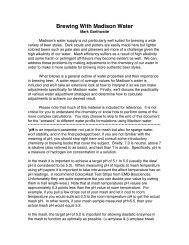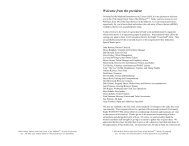The Compleat Distiller
The Compleat Distiller
The Compleat Distiller
Create successful ePaper yourself
Turn your PDF publications into a flip-book with our unique Google optimized e-Paper software.
THE COMPLEAT DISTILLER 46<br />
Immersion element boilers<br />
An immersion-type element is usually mounted through the side of a boiler and is in direct contact with<br />
the liquid. Immersion elements are available in a wide variety of shapes, sizes and power capabilities.<br />
Usually, these elements are designed to bolt to a flange or screw into a special fitting. You can<br />
purchase the appropriate fitting and have it welded or brazed onto almost any style of pot. Another<br />
type of fitting (the bulkhead fitting) is designed for mounting devices through sheets of metal, and if<br />
you have (or can create) a flat surface on your vessel, you can easily mount one of these.<br />
Another route to an immersion boiler is to modify a small electric water heater. <strong>The</strong>se “point of use”<br />
water heaters are readily available in sizes ranging from 20 to 60 liters (5 to 15 US gallons), with<br />
heating elements usually in the 1000 – 2000 watt range. <strong>The</strong>y are well insulated, and have convenient<br />
and well-labeled inlet and outlet connections. <strong>The</strong> outlet will be on the top, and will become the exit<br />
path for vapor. <strong>The</strong> "inlet" may be on the top or the side of the cylinder. It is very important to<br />
differentiate between the "inlet" and "outlet" fittings, because the inlet is often connected to a tube<br />
inside the unit that delivers cold water to the bottom of the tank. It is therefore always immersed in<br />
liquid, and cannot deliver any vapor! <strong>The</strong> inlet needs to have a valve or cap attached that remains<br />
closed except when filling or draining the unit.<br />
Water heaters have built-in thermostats that prevent them from boiling. Since you want the contents to<br />
boil, you must remove this thermostat from the circuit. Some water heaters have a sacrificial anode of<br />
magnesium or magnesium alloy, which should be removed if possible. If you are not completely sure<br />
of your skills as a plumber or an electrician, get someone to do the work for you! Many home brewers<br />
have found that a few bottles of their product can be traded for a lot of work on equipment.<br />
Indirectly heated boilers<br />
<strong>The</strong>re are many advantages to an indirectly heated boiler, but other than the “pot in a pot” technique,<br />
they are difficult and expensive to build. You might be able to find a jacketed cooking vessel at a used<br />
restaurant supply store, and that would be the best way to create a true indirect heating system. Vessels<br />
with heating coils are generally too large to consider for a small-scale boiler.<br />
This method is used extensively in industry, because a single boiler can heat many pieces of equipment.<br />
Industrial applications usually use steam as the heat transfer medium, because it is very efficient.<br />
Steam can be heated to very high temperatures and its own pressure will move it around the system,<br />
while hot water systems require a separate pump.<br />
Whatever the advantages, steam heating should NEVER be attempted by the amateur! STEAM IS<br />
DANGEROUS. Because of the dangers of steam, pressurized boilers require licensing and regular<br />
inspections, and still manage to explode and kill people on a regular basis.<br />
If you want to try this technique - and it can offer significant safety advantages if you are heating with a<br />
flame - then use hot water for the heat transfer medium. NEVER operate a pressurized system.<br />
Boilers - Summary<br />
All of these methods of heating are suitable, and each has advantages and disadvantages, so none of<br />
them can be declared the winner. Choose your design based upon your own unique situation.<br />
You can make a boiler yourself (paying due attention to grounding and electrical safety, or to fire and<br />
ventilation if using open flame heating) or you may choose to buy a boiler ready-made. Small<br />
electrical water heaters are a good option because they're compact, sturdily made, and are usually well<br />
heat insulated (which saves on your electricity bill). Using a water heater for a boiler is described in<br />
more detail later, in the section on Pot Stills.









